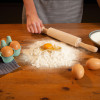
Dive into the world of traditional Italian cuisine with our comprehensive guide on mastering the art of making homemade pasta. From classic spaghetti to sophisticated ravioli, learn everything about choosing the right ingredients, kneading the perfect dough, and crafting exquisite pasta shapes that will impress your family and dinner guests. Get ready to elevate your cooking skills to new heights.
The Soul of Homemade Pasta: The Ingredients
The beauty of making homemade pasta lies in its simplicity. With so few ingredients, quality is paramount. The pasta dough's basic ingredients are flour, eggs, water, and a dash of salt. While all-purpose flour works perfectly fine for homemade pasta, many pasta enthusiasts prefer '00' flour, a finely ground Italian type known for yielding a silkier and more tender pasta. Eggs add richness and color, but the egg-to-flour ratio can be adjusted depending upon desired pasta texture. Using high-quality, fresh ingredients elevates the flavor of your pasta from good to gourmet.
Crafting Perfect Pasta Dough
The heart of making pasta is creating the perfect dough. Many Italian grandmothers create a small well in the flour where they add beaten eggs, salt and water, gradually working the flour in from the edges. Combine the ingredients until they form a cohesive mass, and then the real work begins: kneading. Knead your dough until it becomes smooth and elastic, usually for about 10 minutes. Be patient, because vigorous kneading develops the gluten in the flour, ensuring a firm and springy pasta. It's a little bit of a workout, but certainly worth the effort.
Rolling and Cutting Pasta: A Low-Tech Methodology
Once your dough has rested for some time, the next stage involves rolling and cutting your pasta. You do not need a pasta machine to achieve this. On a lightly floured surface, roll out your dough as thin as possible. For spaghetti or fettuccini, roll your dough into a loose cylinder and slice across into even strips. Unravel the rolls to reveal long, thin strands. For lasagna, simply cut the dough into large squares. To create filled pasta like ravioli or tortellini, place small amounts of your chosen filling on the dough and fold it over, sealing the edges with a bit of water.
It's Cooking Time
Now comes the thrilling part: cooking your homemade pasta. Unlike dry pasta, fresh pasta cooks much quicker, typically in 2-3 minutes. Drop your pasta into boiling, generously salted water and cook until it rises to the surface. For filled pasta, ensure it’s sealed tightly to prevent fillings from escaping. Drain it well and toss it directly into the sauce. Skip the rinse - keeping the starchy cooking liquid on the pasta helps the sauce adhere better. Serve immediately with a generous sprinkling of your choice of cheese for an unbeatable homemade pasta experience.
Set Aside Store-bought Pasta
Once you master the art of homemade pasta, you'll never want to go back to store-bought again. While store-bought pasta offers convenience, the taste, texture, and satisfaction that come from savoring pasta you've made with your own hands are unparalleled. By branching out into making your pasta at home, you're not only learning a new skill but also commanding complete control over the ingredients and flavor. Even more than that, you're participating in an age-old culinary tradition of the Italian cuisine that's as gratifying to carry out as it is to consume.
















